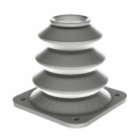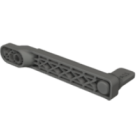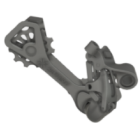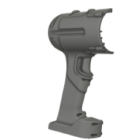3D printing flexible
While 3D printing is often associated with rigid prototypes and structural components, the technology is equally capable of producing flexible, elastic, and soft-touch parts. The ability to print flexible materials has opened new doors across industries — from wearables and medical devices to seals, gaskets, and robotics. Understanding what makes a material flexible, how to print with it, and where it performs best is essential for making the most of this versatile capability.
What makes a 3D printing material flexible?
Flexibility in 3D printing comes down to material chemistry and structure. Most flexible filaments or powders are based on elastomeric polymers — substances with low modulus of elasticity, allowing them to bend, compress, and stretch without breaking. The key characteristics of these materials include:
- shore hardness (softer means more flexible),
- elongation at break (how far it stretches before failure),
- fatigue resistance (endurance under repeated movement).
Whether you’re printing with filament, resin, or powder, these properties define how the final part will behave under stress.
Flexible materials for different technologies
FDM: TPU, TPE, and soft PLA
In filament-based 3D printing, TPU (thermoplastic polyurethane) is by far the most popular flexible material. It offers a balance of elasticity, chemical resistance, and durability. Depending on the Shore rating (e.g., 85A vs. 98A), TPU can be squishy like rubber or stiff like a phone case.
TPE (thermoplastic elastomer) is another option, offering even softer textures, though it can be harder to print due to its rubbery nature. Some manufacturers also offer Soft PLA, which mimics flexible rubber but is easier to use on standard FDM printers.
Printing tips for FDM:
- use a direct drive extruder for better filament control,
- print slower than with rigid materials,
- minimize retraction to avoid stringing.
SLS: flexible TPU powders
In Selective Laser Sintering (SLS), flexible printing is achieved with powders like TPU 88A or TPU 70A. These allow for support-free, highly complex geometries with consistent elasticity throughout the part.
SLS-printed TPU is ideal for functional applications where both softness and durability matter — such as seals, bellows, soft grippers, or wearable components. Unlike FDM, SLS parts don’t require support removal, which is a major benefit when working with delicate, flexible structures.
Other methods
While SLA and DLP generally favor rigid resins, there are some flexible photopolymer resins on the market. However, they tend to be less robust than thermoplastic options and may degrade faster over time.
Material Jetting technologies (like PolyJet) can also print rubber-like materials with excellent detail and multi-material combinations, making them useful for prototyping overmolded or tactile parts.
Can you 3D print flexible plastic?
Yes — and with excellent results, depending on the technology and material you choose. From soft-touch grips to full-scale elastomeric parts, flexible 3D printing materials enable the design and production of parts that bend, stretch, and compress like rubber — with the added benefit of digital manufacturing flexibility.
Applications of flexible 3D printing
Flexible materials are used in a wide range of industries:
- medical: orthotics, prosthetic liners, soft tissue models,
- footwear: midsoles, insoles, and cushioning elements,
- robotics: grippers, joints, and dampers,
- industrial: vibration dampers, flexible seals, hose connectors,
- consumer goods: phone cases, handles, and wearable tech.
These materials bridge the gap between functional performance and comfort — making them a vital tool in any designer’s material toolbox.
Summary
3D printing flexible materials isn’t just possible — it’s reliable, repeatable, and production-ready with the right setup. Whether you need soft-touch surfaces, dynamic parts, or materials that move with the body, there’s a flexible 3D printing option for your application. As additive manufacturing matures, the demand for such materials will only grow, and understanding their behavior and capabilities will give you a clear edge in functional design.
Explore also
- Polymers in 3D printing
- 3D printing of metals
- Biocompatible materials for 3D printing
- Raw materials for 3D printing
- Composites 3D printing
- Recycled 3D printing filament
- Filament types for 3D printing
- What material does a 3D printer use?
- 3D printing strongest material
Related categories













